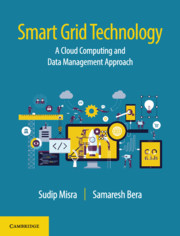Book contents
- Frontmatter
- dedication
- Contents
- Figures
- Tables
- Foreword
- Preface
- Part I Introduction
- Part II Cloud Computing Applications for Smart Grid
- Part III Smart Grid Data Management and Applications
- 11 Smart Meter Data Management
- 12 PHEVs: Internet of Vehicles
- 13 Smart Buildings
- Part IV Smart Grid Design and Deployment
- Index
12 - PHEVs: Internet of Vehicles
from Part III - Smart Grid Data Management and Applications
Published online by Cambridge University Press: 20 October 2018
- Frontmatter
- dedication
- Contents
- Figures
- Tables
- Foreword
- Preface
- Part I Introduction
- Part II Cloud Computing Applications for Smart Grid
- Part III Smart Grid Data Management and Applications
- 11 Smart Meter Data Management
- 12 PHEVs: Internet of Vehicles
- 13 Smart Buildings
- Part IV Smart Grid Design and Deployment
- Index
Summary
Plug-in hybrid electric vehicles (PHEVs) are attracting the interest of researchers due to their unique features such as real-time demand side management and green technology. PHEVs use a combination of electric energy and traditional fossil fuel. They have an electric motor and an internal combustion engine. It is expected that PHEVs will produce less amount of air pollution compared to traditional vehicles. Moreover, PHEVs can charge and discharge their batteries, depending on the real-time energy status of the grid, which is widely termed as vehicle-to-grid (V2G) and grid-to-vehicle (G2V) transfer.
Vehicle-to-grid (V2G) transfer is defined as the energy transfer from an electric vehicle to the power grid. In smart grid, the energy supply from generators and demand from its customers are dynamic over time. Therefore, sometimes, the grid may face supply–demand imbalance, which, in turn, may lead to grid failure. Using the concept of V2G transfer, energy can be supplied to the grid from the vehicle when there is a deficit in energy supply to the grid compared to the energy demand from its customers. Therefore, sudden energy demand peaks can be avoided using such technology.
Vehicles also consume energy to charge their batteries. Consequently, they can charge their batteries when there is a surplus in energy supply to the grid. This energy transfer technology is termed as grid-to-vehicle (G2V) transfer. Therefore, surplus energy can be stored in the PHEVs’ batteries without wasting it. Hence, V2G and G2V techniques play an important role in real-time energy management in the smart grid. It is noteworthy that PHEVs are also integrated with different communication technologies, in order to have real-time energy supply–demand information. Consequently, suitable communication technology is also required for efficient operation of the PHEVs, while integrating them with the smart grid.
Convergence of PHEVs and Internet of Vehicles
Internet-of-vehicles (IoVs) are expected to play a major role in real-time information sharing and gathering information about roads and traffic. It is also useful to process, compute, and release the gathered information to other platforms. Based on the received data, the system can guide its users to take appropriate decisions. Moreover, it can provide Internet connectivity to its users as is done in vehicular ad-hoc networks (VANETs).
Today's PHEVs will become tomorrow's IoVs with the energy management facilities. This is because, in addition to energy management, PHEVs can fulfill the objectives of the concept of IoVs.
- Type
- Chapter
- Information
- Smart Grid TechnologyA Cloud Computing and Data Management Approach, pp. 189 - 206Publisher: Cambridge University PressPrint publication year: 2018



